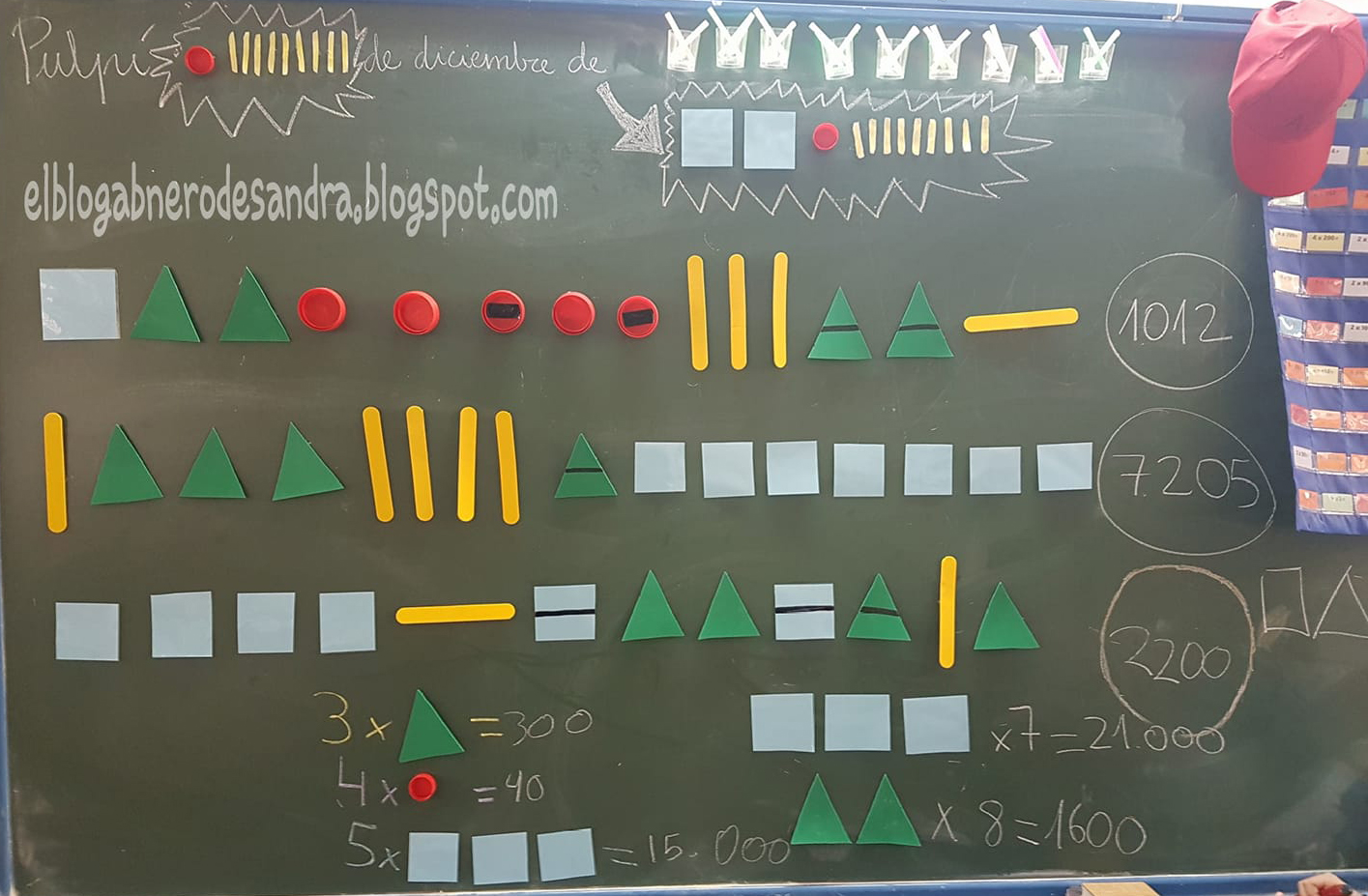Many experts have been warning us for decades: the traditional algorithms used for teaching mathematics are, to say the least, inadequate. The creator of this calculation method, Jaime Martínez, had spent many years observing this reality and he set out to change it. His method, which stands for Open-ended Number-Based Algorithms, aims to reform the traditional teaching of mathematics in order to make operations more comprehensible. Because, according to its creator, when a person understands what they do, “they learn better, learn more, forget less and are able to connect that which they learnt with other new things they learn.”
So he developed an alternative way for children to better understand what they were doing when they were calculating and changed the way operations were taught. With the ABN method, children manipulate quantities. Figures are converted into sticks, into caps, into skittles, into euros. They take shape. They exist. In this way, it is much easier for children to internalise the concept and thus learn what a number is practically on their own. Going from the concrete to the abstract, and not the other way around.
They soon realised that the children understood everything better and much faster. They also greatly improved their mental calculation and estimation skills, their problem-solving skills and, in addition, their attitude towards mathematical learning changed substantially.
This is an example of how the method is applied to younger pupils. This is how they begin to understand numbers.
And once they have understood the concept, they apply it to the rest of the operations.
Now that we have seen how they work, we can better understand their name. Why ABN?
- A for Open-ended (abierto in Spanish). They are open-ended because there isn’t a single way to solve them. Each student can solve them in a different way, depending on their development, mastery of the calculation, strategies, etc. as opposed to the classic algorithms which are closed, in which there is only one way of doing them, they do not allow discretion or alteration in what is prescribed. The usual accounts are nothing more than the blind, rote and mindless application of a previously established set of instructions.
- BN for Number Based. In contrast to the traditional figure-based methods, the ABN method always works with the whole number.
How does it work?
As mentioned above, ABN is based on manipulative learning and on the concrete and familiar experiences of students that allow them to understand all the processes to be carried out in the calculation. These are the key assumptions that characterise this methodology:
- Progress is built on the understanding of previous knowledge.
- All the content is broken down so that the student can easily overcome any difficulties they encounter.
- All learning is interrelated, thus avoiding watertight content and disconnected shifts among them.
- A wide variety of pathways are explored as methods of resolution (hence the name open-ended), so that the learner is given a high degree of decision-making capacity and the option to adapt problem situations to the student’s abilities and to the strategies they master best.
How the ABN method emerged and spread
Jorge Martínez, a public-school teacher for eight years and an inspector for another 37 years, had spent years thinking about the concept and the basis of what would later become ABN mathematics. His doctoral thesis, published in 1995, illustrated this, and so did some subsequent publications such as “The undesired (and devastating) effects of traditional methods for learning numbers and the four algorithms for basic operations” (Martínez Montero, 2001). Through a case study, in this article, Montero demonstrated the negative consequences of traditional methods in three main areas: the impoverishment of spontaneous strategies and methods for dealing with non-routine computational tasks; the implementation of serious conceptual errors in the fundamentals of computation; and the students’ perceived lack of meaning regarding quantities expressed in numbers.
Therefore, Martínez Montero developed his method and began to implement it in two public schools in the province of Cádiz (Spain) during the 2008-2009 school year. Immediately, and based on the success of its results, the method began to spread very quickly throughout Spain and to some Latin American countries such as Colombia, Mexico, Peru, Chile and Argentina. The Internet and the development of specific software and a multitude of manipulative materials and activities were a contributing factor in its spread as well. The impact has been so great that the Anaya publishing house has decided to incorporate the method as the backbone of some of its mathematics books.
Teaching implications
For their part, the teachers who have applied it, encouraged and motivated by the achievements of their students, have been their greatest preachers among other colleagues and even the students’ own families.
What are the advantages of this method for teachers? Why is it so convincing for teachers? According to Nuria Climent, head professor in the area of Mathematics didactics in the Faculty of Education, Psychology and Sports Sciences at the University of Huelva, these are some of the reasons:
- The method focuses mostly on elementary arithmetic, the area that is most worked on at school and in which teachers feel very confident.
- It has been developed with a high level of detail: there are multiple manipulative materials, activities, tutorials to teach parents, training courses for teachers, etc.
- It allows for a personalised learning approach and is highly motivating for learners.
However, for Climent, the method also has some limitations. For example:
- Only basic operations and numbers are worked on. No geometry, no statistics, no non-arithmetic problem-solving.
- As we increase the level, conventional algorithms become more practical than ABN algorithms.
The interest in the ABN method in the teaching community has also been evidenced by its dissemination in teacher training forums and communities. The training faculties of the UCO in Córdoba and the UAM in Madrid have organised congresses where the methodology was disseminated. It is also consolidating itself as a subject of special interest in the training of active teachers in almost all the autonomous regions and has become object of research at university teaching level. In this sense, there are numerous end-of-degree projects based on various aspects of the method and several doctoral theses in development, and, in fact, several lines of research have been launched at the Universities of Cordoba, Cadiz and the University of Concepción in Chile, where excellent comparative results with respect to the traditional method, both regarding calculus and problem-solving, stand out.
Shortly after its first implementation in Cádiz, Martínez Montero published an article in which he carried out a comparative study on the results of his method. The conclusions were clear: students using the ABN method of calculation perform better in mental arithmetic, operations and problem-solving than those using the traditional or CBC method (Closed Figure-Based method).
What is the value of ABN?
What are the strengths of this methodology?
- Better quality learning. When nursery school pupils start primary school, they do so with a broad numerical sense, as well as with a high capacity for calculation, enabling them to enter this new stage knowing how to add and subtract up to 100, regardless of the numbers carried. Likewise, in primary school, pupils achieve the calculation objectives for the whole stage with a two-year advantage with respect to the traditional algorithm, which allows them to perfect it and to accelerate subsequent content.
- Significant improvement in estimation and calculation skills, based on a broad mastery of numeracy without the need for “tricks” or added mental arithmetic procedures.
- The calculation method is adapted to the pupils and not the other way round, to such an extent that any operation can be carried out by the pupils. This is because there is no single way of calculating: each learner chooses their own path, thus avoiding leaving many of them behind because they have not mastered procedural instructions.
- It develops student creativity, who even manage to invent new operations that simplify the procedure and also get a head start on further learning.
- It develops children’s self-confidence, which makes them lose their fear of facing operations, and generates a high capacity for self-correction in the face of their own calculation errors as well.
- Substantial improvement in problem-solving. All ABN operations arise from concrete problem situations, allowing for step-by-step development of these operations, their understanding and their relation to the problem posed.
- As a consequence of all the above, the method allows to raise the level and to advance the natural learning of subsequent contents.
- As the pupils understand what they are doing, the subject becomes a game that continually offers them new challenges, with all that it entails in terms of motivation for new learning.
- Teachers’ satisfaction with their work increases.
- Families support and defend the method.
All these strengths are undoubtedly the main reasons for its strong growth and establishment. They are also a strong backing for the use of new and innovative methodologies that allow mathematics to cease to be that subject which is feared and hated on equal parts, and to become, in the words of its creator, “a powerful tool for the intellectual development of children and a fundamental piece in the construction of their logical and critical thinking.”
REFERENCES
Jiménez Falce, M. (13 April 2018). ABN is an interesting method, but it also has its limitations. Significativa. https://significativa.org/entrevista-a-nuria-climent-2-de-4-abn/
Martínez Montero, J. (2001). The undesired (and devastating) effects of traditional methods for learning numbers and the four algorithms for basic operations. Epsilon: Revista de la Sociedad Andaluza de Educación Matemática Thales, ISSN 1131-9321, ISSN-e 2340-714X, No. 49, 2001, pp. 13-26.
Martínez Montero, J. (2011). The open-ended number-based calculation (ABN) method as a pioneering alternative to traditional Closed Figure-Based method (CBC). Bordón. Revista de Pedagogía. [Journal of Pedagogy.]






